FA 4312 Blues Essay: Analyzing Songs on Facts of Life and Will to Live
VerifiedAdded on 2023/04/20
|5
|1470
|366
Essay
AI Summary
This essay examines the blues genre through the lens of two key figures: Willie Dixon and Nat D. Williams. Dixon viewed the blues as reflections of life's realities, while Williams emphasized the genre's ability to instill a will to live. The essay analyzes two blues songs, "Take a Little Walk with Me" by Robert Lockwood and "Swing Low, Chariot" by Sister O.M. Terrell, to illustrate these perspectives. "Take a Little Walk with Me" is interpreted as an expression of the desire for escape and love amidst the struggles of everyday life, echoing Dixon's view. "Swing Low, Chariot" is analyzed as a coded song of hope and resilience in the face of slavery, supporting Williams' claim that the blues provide a means to persevere. The essay highlights how these songs, born from the hardships of the early 20th century, continue to resonate today, offering courage and optimism to listeners dealing with their own challenges.
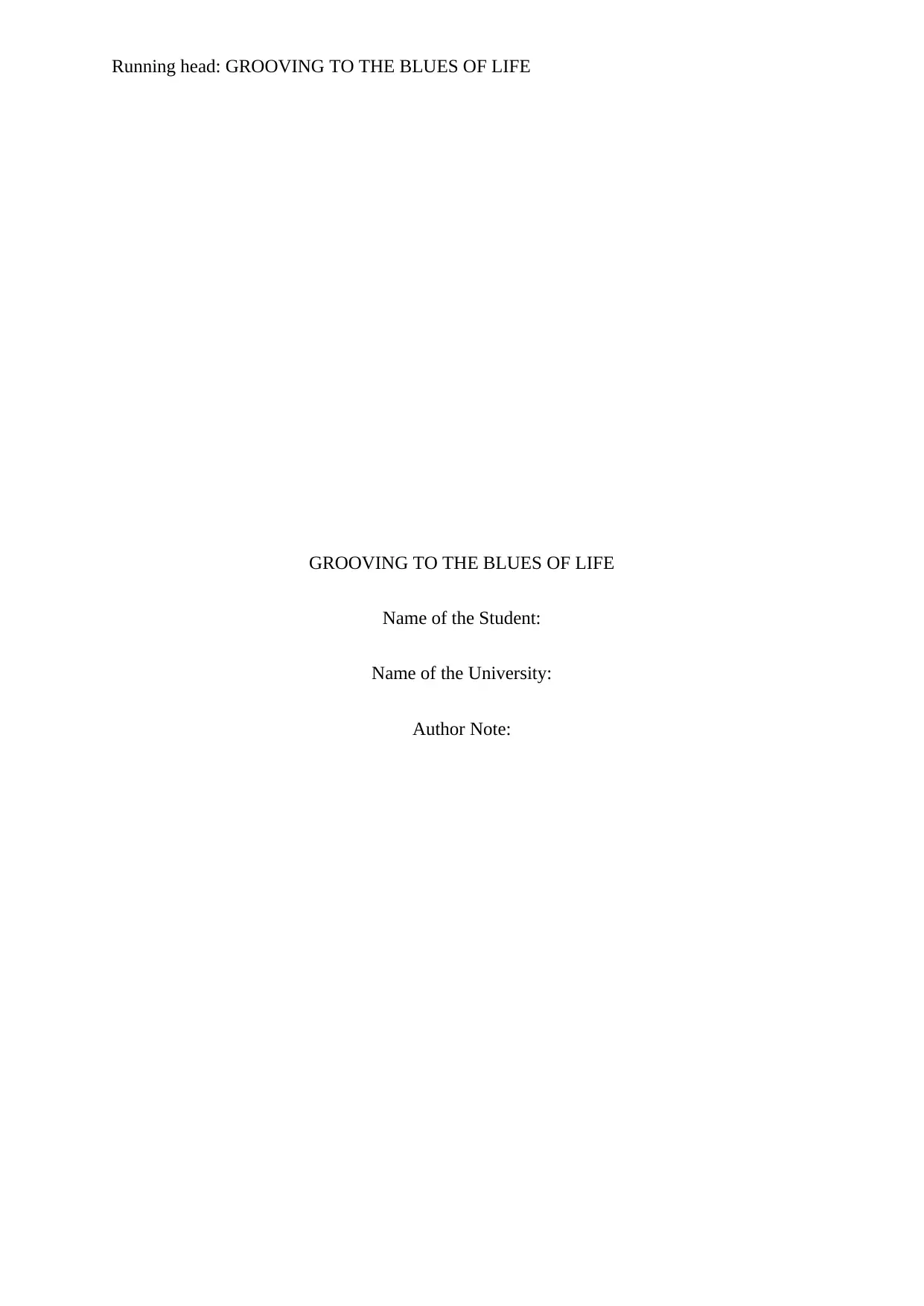
Running head: GROOVING TO THE BLUES OF LIFE
GROOVING TO THE BLUES OF LIFE
Name of the Student:
Name of the University:
Author Note:
GROOVING TO THE BLUES OF LIFE
Name of the Student:
Name of the University:
Author Note:
Paraphrase This Document
Need a fresh take? Get an instant paraphrase of this document with our AI Paraphraser
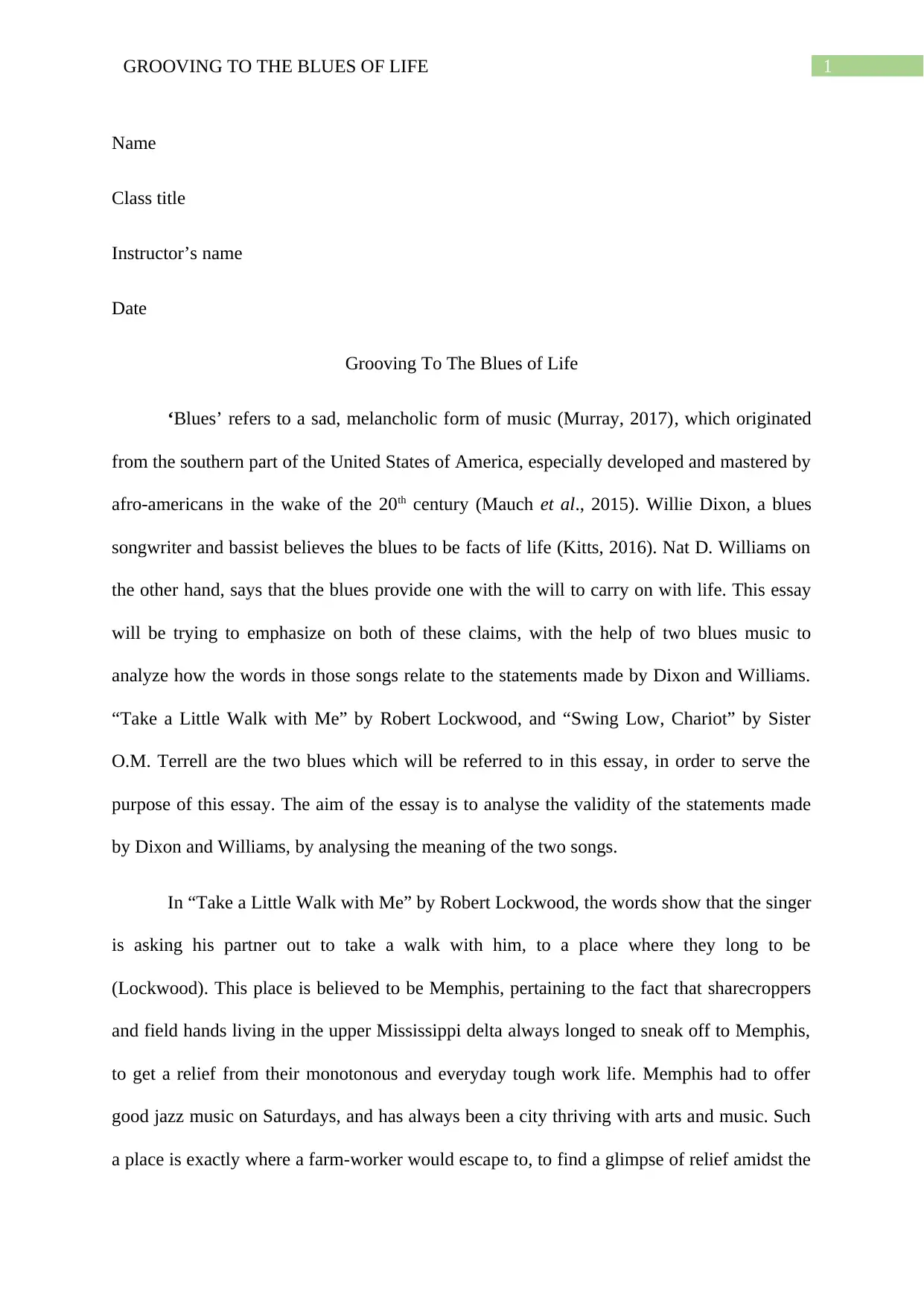
1GROOVING TO THE BLUES OF LIFE
Name
Class title
Instructor’s name
Date
Grooving To The Blues of Life
‘Blues’ refers to a sad, melancholic form of music (Murray, 2017), which originated
from the southern part of the United States of America, especially developed and mastered by
afro-americans in the wake of the 20th century (Mauch et al., 2015). Willie Dixon, a blues
songwriter and bassist believes the blues to be facts of life (Kitts, 2016). Nat D. Williams on
the other hand, says that the blues provide one with the will to carry on with life. This essay
will be trying to emphasize on both of these claims, with the help of two blues music to
analyze how the words in those songs relate to the statements made by Dixon and Williams.
“Take a Little Walk with Me” by Robert Lockwood, and “Swing Low, Chariot” by Sister
O.M. Terrell are the two blues which will be referred to in this essay, in order to serve the
purpose of this essay. The aim of the essay is to analyse the validity of the statements made
by Dixon and Williams, by analysing the meaning of the two songs.
In “Take a Little Walk with Me” by Robert Lockwood, the words show that the singer
is asking his partner out to take a walk with him, to a place where they long to be
(Lockwood). This place is believed to be Memphis, pertaining to the fact that sharecroppers
and field hands living in the upper Mississippi delta always longed to sneak off to Memphis,
to get a relief from their monotonous and everyday tough work life. Memphis had to offer
good jazz music on Saturdays, and has always been a city thriving with arts and music. Such
a place is exactly where a farm-worker would escape to, to find a glimpse of relief amidst the
Name
Class title
Instructor’s name
Date
Grooving To The Blues of Life
‘Blues’ refers to a sad, melancholic form of music (Murray, 2017), which originated
from the southern part of the United States of America, especially developed and mastered by
afro-americans in the wake of the 20th century (Mauch et al., 2015). Willie Dixon, a blues
songwriter and bassist believes the blues to be facts of life (Kitts, 2016). Nat D. Williams on
the other hand, says that the blues provide one with the will to carry on with life. This essay
will be trying to emphasize on both of these claims, with the help of two blues music to
analyze how the words in those songs relate to the statements made by Dixon and Williams.
“Take a Little Walk with Me” by Robert Lockwood, and “Swing Low, Chariot” by Sister
O.M. Terrell are the two blues which will be referred to in this essay, in order to serve the
purpose of this essay. The aim of the essay is to analyse the validity of the statements made
by Dixon and Williams, by analysing the meaning of the two songs.
In “Take a Little Walk with Me” by Robert Lockwood, the words show that the singer
is asking his partner out to take a walk with him, to a place where they long to be
(Lockwood). This place is believed to be Memphis, pertaining to the fact that sharecroppers
and field hands living in the upper Mississippi delta always longed to sneak off to Memphis,
to get a relief from their monotonous and everyday tough work life. Memphis had to offer
good jazz music on Saturdays, and has always been a city thriving with arts and music. Such
a place is exactly where a farm-worker would escape to, to find a glimpse of relief amidst the
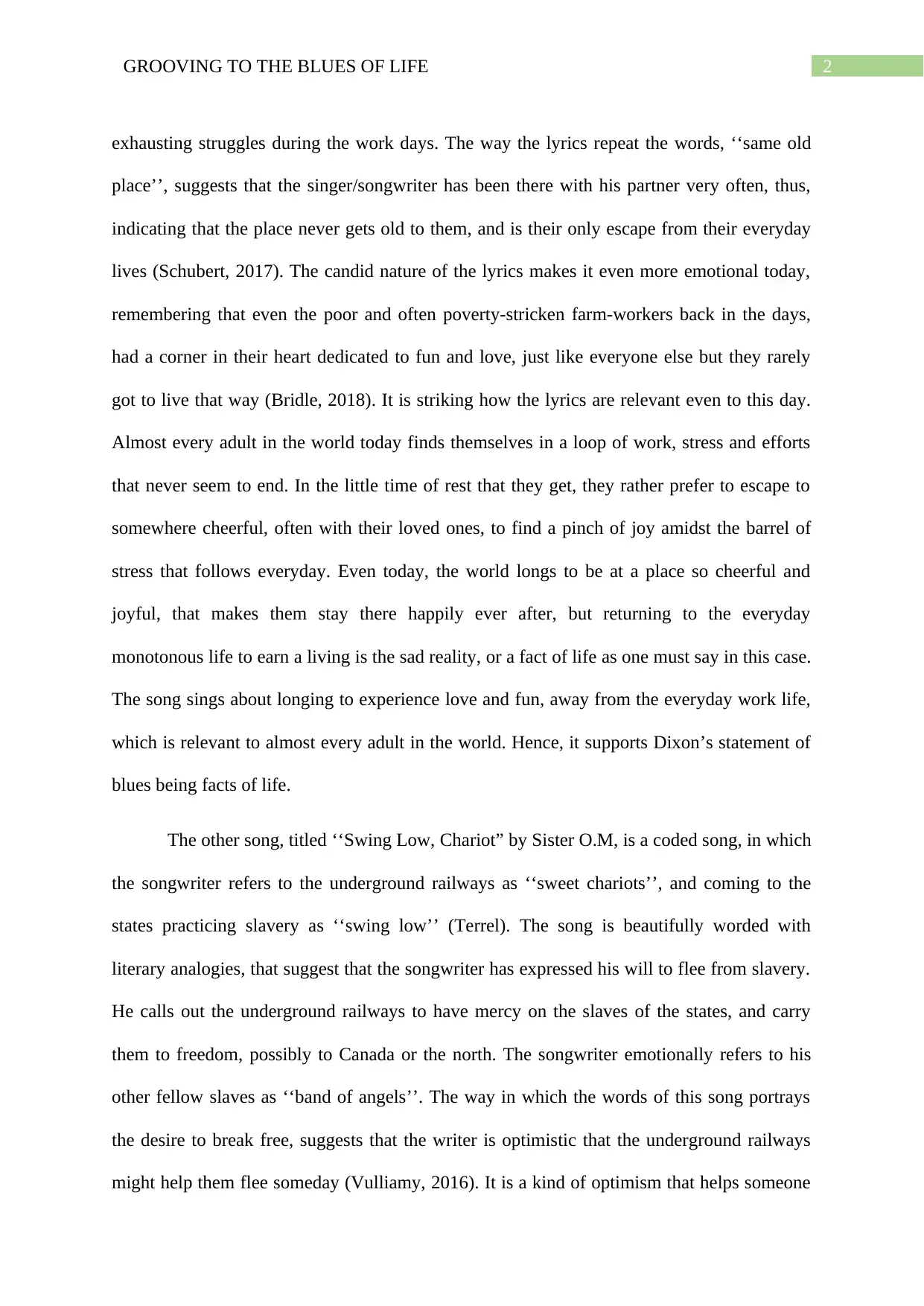
2GROOVING TO THE BLUES OF LIFE
exhausting struggles during the work days. The way the lyrics repeat the words, ‘‘same old
place’’, suggests that the singer/songwriter has been there with his partner very often, thus,
indicating that the place never gets old to them, and is their only escape from their everyday
lives (Schubert, 2017). The candid nature of the lyrics makes it even more emotional today,
remembering that even the poor and often poverty-stricken farm-workers back in the days,
had a corner in their heart dedicated to fun and love, just like everyone else but they rarely
got to live that way (Bridle, 2018). It is striking how the lyrics are relevant even to this day.
Almost every adult in the world today finds themselves in a loop of work, stress and efforts
that never seem to end. In the little time of rest that they get, they rather prefer to escape to
somewhere cheerful, often with their loved ones, to find a pinch of joy amidst the barrel of
stress that follows everyday. Even today, the world longs to be at a place so cheerful and
joyful, that makes them stay there happily ever after, but returning to the everyday
monotonous life to earn a living is the sad reality, or a fact of life as one must say in this case.
The song sings about longing to experience love and fun, away from the everyday work life,
which is relevant to almost every adult in the world. Hence, it supports Dixon’s statement of
blues being facts of life.
The other song, titled ‘‘Swing Low, Chariot” by Sister O.M, is a coded song, in which
the songwriter refers to the underground railways as ‘‘sweet chariots’’, and coming to the
states practicing slavery as ‘‘swing low’’ (Terrel). The song is beautifully worded with
literary analogies, that suggest that the songwriter has expressed his will to flee from slavery.
He calls out the underground railways to have mercy on the slaves of the states, and carry
them to freedom, possibly to Canada or the north. The songwriter emotionally refers to his
other fellow slaves as ‘‘band of angels’’. The way in which the words of this song portrays
the desire to break free, suggests that the writer is optimistic that the underground railways
might help them flee someday (Vulliamy, 2016). It is a kind of optimism that helps someone
exhausting struggles during the work days. The way the lyrics repeat the words, ‘‘same old
place’’, suggests that the singer/songwriter has been there with his partner very often, thus,
indicating that the place never gets old to them, and is their only escape from their everyday
lives (Schubert, 2017). The candid nature of the lyrics makes it even more emotional today,
remembering that even the poor and often poverty-stricken farm-workers back in the days,
had a corner in their heart dedicated to fun and love, just like everyone else but they rarely
got to live that way (Bridle, 2018). It is striking how the lyrics are relevant even to this day.
Almost every adult in the world today finds themselves in a loop of work, stress and efforts
that never seem to end. In the little time of rest that they get, they rather prefer to escape to
somewhere cheerful, often with their loved ones, to find a pinch of joy amidst the barrel of
stress that follows everyday. Even today, the world longs to be at a place so cheerful and
joyful, that makes them stay there happily ever after, but returning to the everyday
monotonous life to earn a living is the sad reality, or a fact of life as one must say in this case.
The song sings about longing to experience love and fun, away from the everyday work life,
which is relevant to almost every adult in the world. Hence, it supports Dixon’s statement of
blues being facts of life.
The other song, titled ‘‘Swing Low, Chariot” by Sister O.M, is a coded song, in which
the songwriter refers to the underground railways as ‘‘sweet chariots’’, and coming to the
states practicing slavery as ‘‘swing low’’ (Terrel). The song is beautifully worded with
literary analogies, that suggest that the songwriter has expressed his will to flee from slavery.
He calls out the underground railways to have mercy on the slaves of the states, and carry
them to freedom, possibly to Canada or the north. The songwriter emotionally refers to his
other fellow slaves as ‘‘band of angels’’. The way in which the words of this song portrays
the desire to break free, suggests that the writer is optimistic that the underground railways
might help them flee someday (Vulliamy, 2016). It is a kind of optimism that helps someone
⊘ This is a preview!⊘
Do you want full access?
Subscribe today to unlock all pages.

Trusted by 1+ million students worldwide
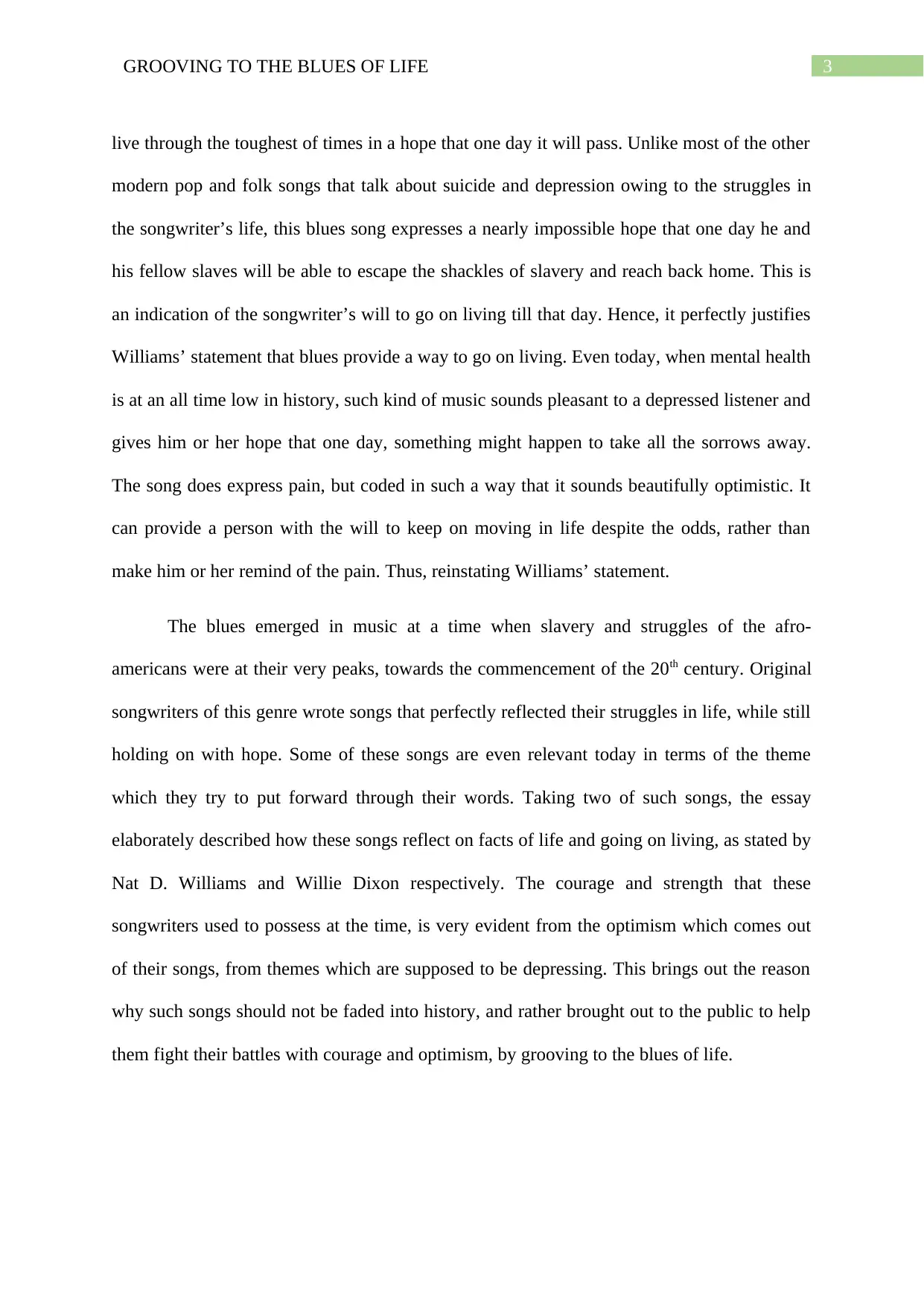
3GROOVING TO THE BLUES OF LIFE
live through the toughest of times in a hope that one day it will pass. Unlike most of the other
modern pop and folk songs that talk about suicide and depression owing to the struggles in
the songwriter’s life, this blues song expresses a nearly impossible hope that one day he and
his fellow slaves will be able to escape the shackles of slavery and reach back home. This is
an indication of the songwriter’s will to go on living till that day. Hence, it perfectly justifies
Williams’ statement that blues provide a way to go on living. Even today, when mental health
is at an all time low in history, such kind of music sounds pleasant to a depressed listener and
gives him or her hope that one day, something might happen to take all the sorrows away.
The song does express pain, but coded in such a way that it sounds beautifully optimistic. It
can provide a person with the will to keep on moving in life despite the odds, rather than
make him or her remind of the pain. Thus, reinstating Williams’ statement.
The blues emerged in music at a time when slavery and struggles of the afro-
americans were at their very peaks, towards the commencement of the 20th century. Original
songwriters of this genre wrote songs that perfectly reflected their struggles in life, while still
holding on with hope. Some of these songs are even relevant today in terms of the theme
which they try to put forward through their words. Taking two of such songs, the essay
elaborately described how these songs reflect on facts of life and going on living, as stated by
Nat D. Williams and Willie Dixon respectively. The courage and strength that these
songwriters used to possess at the time, is very evident from the optimism which comes out
of their songs, from themes which are supposed to be depressing. This brings out the reason
why such songs should not be faded into history, and rather brought out to the public to help
them fight their battles with courage and optimism, by grooving to the blues of life.
live through the toughest of times in a hope that one day it will pass. Unlike most of the other
modern pop and folk songs that talk about suicide and depression owing to the struggles in
the songwriter’s life, this blues song expresses a nearly impossible hope that one day he and
his fellow slaves will be able to escape the shackles of slavery and reach back home. This is
an indication of the songwriter’s will to go on living till that day. Hence, it perfectly justifies
Williams’ statement that blues provide a way to go on living. Even today, when mental health
is at an all time low in history, such kind of music sounds pleasant to a depressed listener and
gives him or her hope that one day, something might happen to take all the sorrows away.
The song does express pain, but coded in such a way that it sounds beautifully optimistic. It
can provide a person with the will to keep on moving in life despite the odds, rather than
make him or her remind of the pain. Thus, reinstating Williams’ statement.
The blues emerged in music at a time when slavery and struggles of the afro-
americans were at their very peaks, towards the commencement of the 20th century. Original
songwriters of this genre wrote songs that perfectly reflected their struggles in life, while still
holding on with hope. Some of these songs are even relevant today in terms of the theme
which they try to put forward through their words. Taking two of such songs, the essay
elaborately described how these songs reflect on facts of life and going on living, as stated by
Nat D. Williams and Willie Dixon respectively. The courage and strength that these
songwriters used to possess at the time, is very evident from the optimism which comes out
of their songs, from themes which are supposed to be depressing. This brings out the reason
why such songs should not be faded into history, and rather brought out to the public to help
them fight their battles with courage and optimism, by grooving to the blues of life.
Paraphrase This Document
Need a fresh take? Get an instant paraphrase of this document with our AI Paraphraser
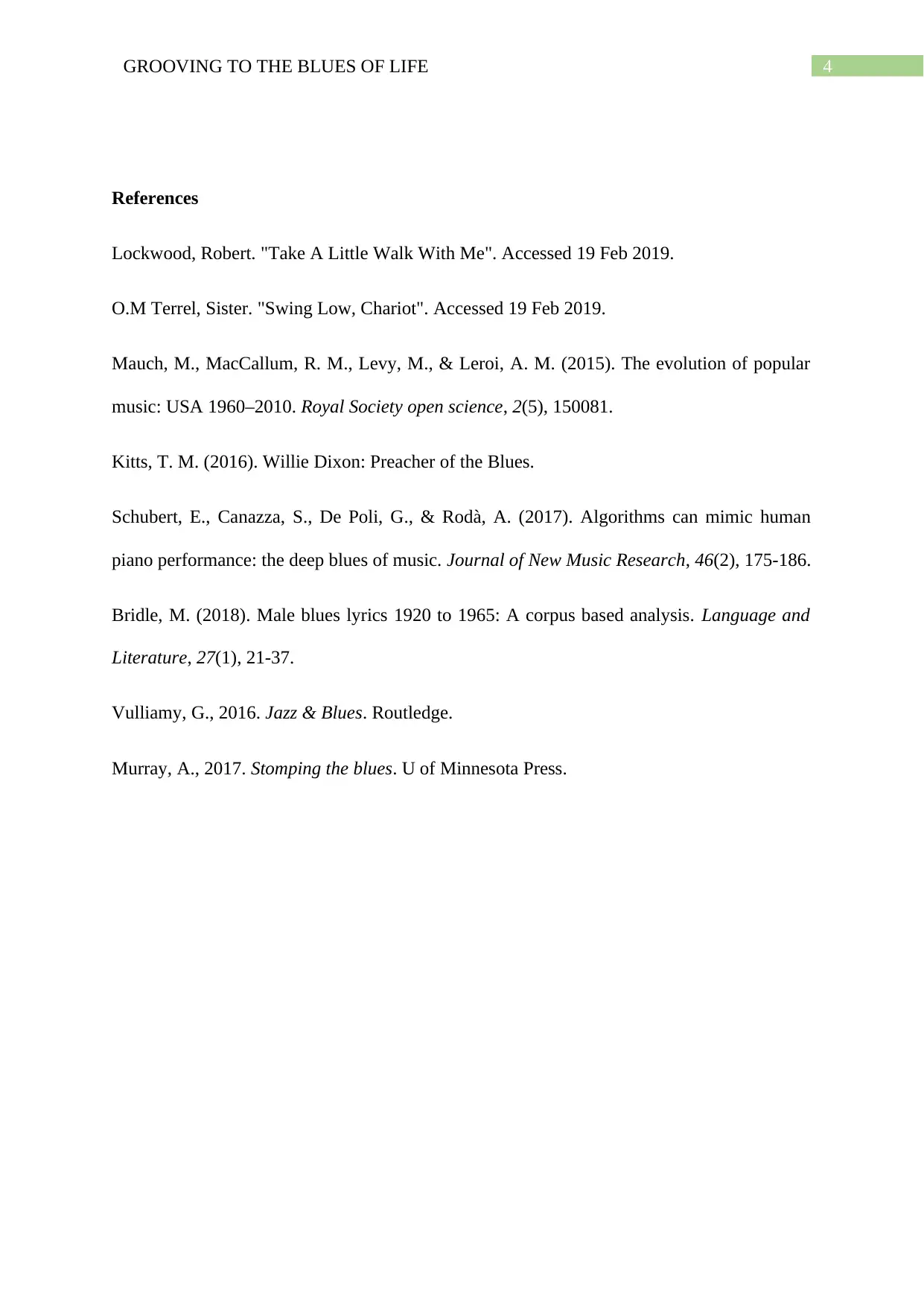
4GROOVING TO THE BLUES OF LIFE
References
Lockwood, Robert. "Take A Little Walk With Me". Accessed 19 Feb 2019.
O.M Terrel, Sister. "Swing Low, Chariot". Accessed 19 Feb 2019.
Mauch, M., MacCallum, R. M., Levy, M., & Leroi, A. M. (2015). The evolution of popular
music: USA 1960–2010. Royal Society open science, 2(5), 150081.
Kitts, T. M. (2016). Willie Dixon: Preacher of the Blues.
Schubert, E., Canazza, S., De Poli, G., & Rodà, A. (2017). Algorithms can mimic human
piano performance: the deep blues of music. Journal of New Music Research, 46(2), 175-186.
Bridle, M. (2018). Male blues lyrics 1920 to 1965: A corpus based analysis. Language and
Literature, 27(1), 21-37.
Vulliamy, G., 2016. Jazz & Blues. Routledge.
Murray, A., 2017. Stomping the blues. U of Minnesota Press.
References
Lockwood, Robert. "Take A Little Walk With Me". Accessed 19 Feb 2019.
O.M Terrel, Sister. "Swing Low, Chariot". Accessed 19 Feb 2019.
Mauch, M., MacCallum, R. M., Levy, M., & Leroi, A. M. (2015). The evolution of popular
music: USA 1960–2010. Royal Society open science, 2(5), 150081.
Kitts, T. M. (2016). Willie Dixon: Preacher of the Blues.
Schubert, E., Canazza, S., De Poli, G., & Rodà, A. (2017). Algorithms can mimic human
piano performance: the deep blues of music. Journal of New Music Research, 46(2), 175-186.
Bridle, M. (2018). Male blues lyrics 1920 to 1965: A corpus based analysis. Language and
Literature, 27(1), 21-37.
Vulliamy, G., 2016. Jazz & Blues. Routledge.
Murray, A., 2017. Stomping the blues. U of Minnesota Press.
1 out of 5
Your All-in-One AI-Powered Toolkit for Academic Success.
+13062052269
info@desklib.com
Available 24*7 on WhatsApp / Email
![[object Object]](/_next/static/media/star-bottom.7253800d.svg)
Unlock your academic potential
Copyright © 2020–2025 A2Z Services. All Rights Reserved. Developed and managed by ZUCOL.

